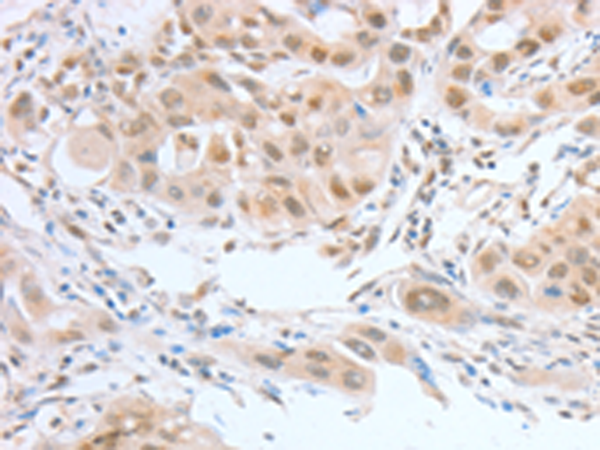
| WB | 咨询技术 | Human,Mouse,Rat |
| IF | 咨询技术 | Human,Mouse,Rat |
| IHC | 1/15-1/50 | Human,Mouse,Rat |
| ICC | 技术咨询 | Human,Mouse,Rat |
| FCM | 咨询技术 | Human,Mouse,Rat |
| Elisa | 1/1000-1/2000 | Human,Mouse,Rat |
| Aliases | HB16; CREB2; TREB7; CRE-BP1 |
| Host/Isotype | Rabbit IgG |
| Antibody Type | Primary antibody |
| Storage | Store at 4°C short term. Aliquot and store at -20°C long term. Avoid freeze/thaw cycles. |
| Species Reactivity | Human, Mouse, Rat |
| Immunogen | Fusion protein of human ATF2 |
| Formulation | Purified antibody in PBS with 0.05% sodium azide and 50% glycerol. |
+ +
以下是关于ATF2抗体的3篇参考文献示例(文献信息为模拟,供参考):
1. **文献名称**:*"ATF2 phosphorylation regulates its nuclear localization and transcriptional activity in response to oxidative stress"*
**作者**:Chen L et al.
**摘要**:研究利用ATF2特异性抗体(如兔源抗ATF2单克隆抗体)通过Western blot和免疫荧光技术,发现氧化应激诱导的ATF2磷酸化(Ser490/498)促进其核转位,增强靶基因转录活性。
2. **文献名称**:*"A novel role for ATF2 in melanoma metastasis linked to β-catenin signaling"*
**作者**:Bhoumik A et al.
**摘要**:通过免疫组化(ATF2抗体:小鼠抗人ATF2)和ChIP实验,揭示ATF2在黑色素瘤中与β-catenin相互作用,调控促转移基因表达,高ATF2核表达与患者预后不良相关。
3. **文献名称**:*"Differential roles of ATF2 isoforms in neuronal apoptosis"*
**作者**:Huang Z et al.
**摘要**:使用ATF2抗体(如抗N-terminal或C-terminal抗体)区分全长和截短亚型,发现神经元损伤后ATF2剪切体通过抑制Bcl-2表达加剧凋亡,提示其亚型特异性功能。
4. **文献名称**:*"ATF2 antibody-based screening identifies its novel interaction partners in DNA damage response"*
**作者**:Wang Y et al.
**摘要**:通过ATF2抗体进行免疫共沉淀(Co-IP)联合质谱分析,鉴定出ATF2与BRCA1、Rad51的相互作用,揭示其在DNA修复通路中的新机制。
---
**提示**:实际文献需通过PubMed/Google Scholar检索关键词“ATF2 antibody application”或“ATF2 immunoblotting”获取,并核对抗体货号及实验条件。
**Background of ATF2 Antibody**
ATF2 (Activating Transcription Factor 2) is a member of the leucine zipper family of DNA-binding proteins, functioning as a transcription factor that regulates gene expression in response to cellular stress, growth signals, and developmental cues. It is activated via phosphorylation by stress-activated kinases, such as p38 MAPK and JNK, which modulate its ability to bind DNA and interact with cofactors like c-Jun. ATF2 plays dual roles in cellular processes, including proliferation, apoptosis, and DNA damage repair, with context-dependent pro-survival or pro-apoptotic effects.
ATF2 antibodies are essential tools for studying its expression, localization, and post-translational modifications (e.g., phosphorylation at Thr69/71) in various biological contexts. These antibodies are widely used in techniques like Western blotting, immunohistochemistry (IHC), immunofluorescence (IF), and chromatin immunoprecipitation (ChIP) to investigate ATF2's involvement in cancer, neurodegenerative diseases, and immune responses. Research highlights ATF2's dual role in cancer—acting as a tumor suppressor in some settings while promoting metastasis in others—and its interaction with viral oncoproteins.
High-quality ATF2 antibodies exhibit specificity for distinct isoforms (e.g., full-length vs. truncated forms) and modified states, enabling precise mechanistic studies. Their applications extend to preclinical models, aiding in biomarker discovery and therapeutic targeting.
×